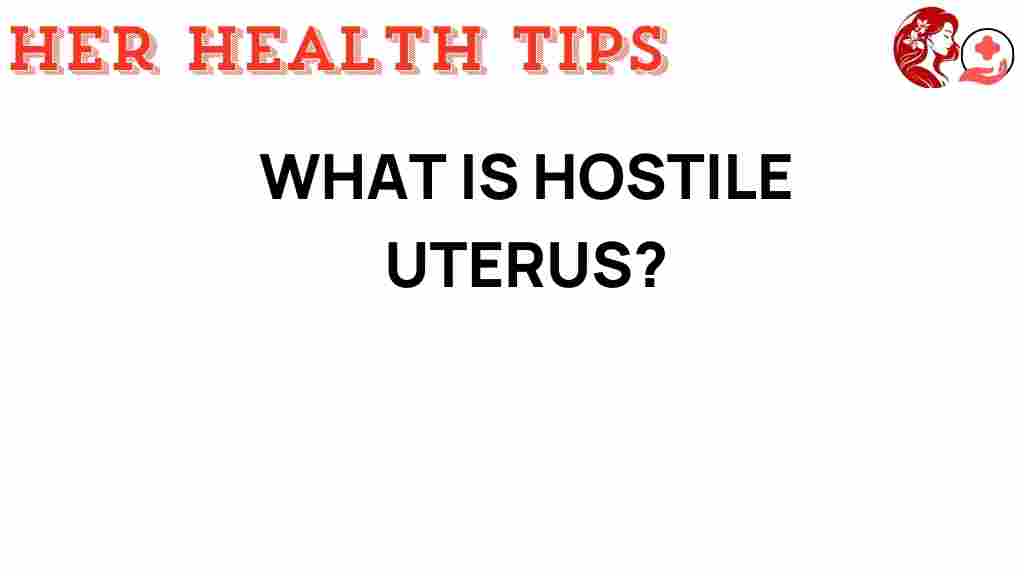Unraveling the Mystery of the Hostile Uterus
The journey through reproductive health can often be fraught with challenges, especially for women facing fertility issues. One of the more perplexing conditions that can contribute to infertility is known as a “hostile uterus.” Understanding this condition is crucial for those who are trying to conceive. In this article, we will delve into the concept of a hostile uterus, explore various uterine conditions, discuss diagnosis and treatment options, and provide valuable medical insights into women’s health and infertility.
What is a Hostile Uterus?
A hostile uterus refers to a uterine environment that is unfavorable for successful implantation of an embryo. This condition can significantly impact fertility and may lead to challenges in sustaining a pregnancy. Various factors can contribute to a hostile uterine environment, including anatomical abnormalities, hormonal imbalances, and the presence of certain medical conditions.
Common Uterine Conditions Associated with a Hostile Uterus
Several uterine conditions may be categorized under the umbrella of a hostile uterus. Understanding these conditions is essential for proper diagnosis and treatment:
- Uterine Fibroids: These noncancerous growths in the uterus can distort the shape of the uterine cavity and interfere with blood flow, potentially making it difficult for an embryo to implant.
- Endometriosis: This condition occurs when tissue similar to the lining inside the uterus grows outside the uterus, leading to inflammation and scarring, which may affect fertility.
- Uterine Polyps: These are benign growths on the uterine lining that can also hinder implantation and lead to other fertility issues.
- Asherman’s Syndrome: This condition involves the formation of scar tissue in the uterus, often resulting from previous surgeries, which can disrupt the normal uterine environment.
- Congenital Anomalies: Some women may be born with uterine anomalies, such as a septate or bicornuate uterus, which can affect implantation and pregnancy.
Diagnosis of a Hostile Uterus
Diagnosing a hostile uterus involves a comprehensive evaluation of a woman’s reproductive health. The following diagnostic methods are commonly used:
- Pelvic Ultrasound: This imaging technique helps visualize the uterus and identify any abnormalities such as fibroids or polyps.
- Hysterosalpingography (HSG): This X-ray procedure involves injecting dye into the uterus and fallopian tubes to assess their shape and check for blockages.
- Sonohysterography: Also known as saline infusion sonography, this test uses saline solution to expand the uterine cavity for better imaging.
- Endometrial Biopsy: A sample of the uterine lining is taken to check for any abnormalities that may affect fertility.
- Laparoscopy: In some cases, a minimally invasive surgical procedure is performed to directly view the uterus and surrounding organs and check for conditions like endometriosis.
Treatment Options for a Hostile Uterus
Once diagnosed, there are various treatment options available to address a hostile uterus and improve fertility outcomes:
- Medications: Hormonal treatments may be prescribed to correct hormonal imbalances that could contribute to a hostile uterine environment.
- Surgical Interventions: Procedures to remove fibroids, polyps, or scar tissue (Asherman’s syndrome) can help restore normal uterine function.
- Assisted Reproductive Technology (ART): In vitro fertilization (IVF) may be recommended, especially if other treatments have not been successful. IVF allows for direct implantation of embryos into the uterus.
- Lifestyle Modifications: Maintaining a healthy lifestyle, including proper nutrition and exercise, can improve overall reproductive health.
- Fertility Counseling: Seeking support from a fertility specialist or counselor can help address emotional challenges and provide strategies for coping with infertility.
Step-by-Step Process for Managing a Hostile Uterus
Managing a hostile uterus often involves a systematic approach:
- Consultation: Schedule an appointment with a reproductive health specialist to discuss fertility issues and symptoms.
- Diagnostic Testing: Undergo recommended tests to identify any uterine conditions.
- Develop a Treatment Plan: Based on the diagnosis, work with your doctor to create a personalized treatment plan.
- Implement Treatment: Follow through with prescribed medications or surgical options as directed by your healthcare provider.
- Monitor Progress: Regular follow-ups will help assess the effectiveness of the treatment and make adjustments as needed.
- Explore ART Options: If natural conception remains challenging, consider discussing ART options like IVF with your specialist.
Troubleshooting Common Issues with a Hostile Uterus
Women facing issues related to a hostile uterus may encounter various challenges. Here are some troubleshooting tips:
- Communication with Healthcare Providers: Always maintain open lines of communication with your doctor regarding any changes in symptoms or side effects from treatments.
- Stay Informed: Educate yourself about your condition. Knowledge can empower you to make informed decisions about your reproductive health.
- Join Support Groups: Connecting with others who are experiencing similar fertility issues can provide emotional support and helpful resources.
- Track Your Cycle: Keeping a detailed record of your menstrual cycle can help identify patterns and issues that may need to be addressed.
Conclusion
Understanding the concept of a hostile uterus is essential for women facing fertility issues. By recognizing the various uterine conditions that can contribute to this environment, obtaining a proper diagnosis, and exploring treatment options, women can take proactive steps towards improving their reproductive health. If you suspect that you may have a hostile uterus or are experiencing infertility, consult with a healthcare provider to discuss your options.
For further information on reproductive health and infertility, consider visiting this helpful resource.
Remember, you are not alone on this journey. With the right support and medical insights, many women are able to navigate the challenges associated with a hostile uterus and achieve their dreams of motherhood.
This article is in the category Reproductive and created by HerHealthTips Team
